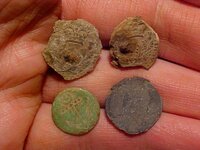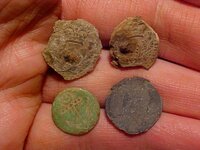Iron Patch
Gold Member
- Sep 28, 2007
- 19,254
- 8,732
- 🥇 Banner finds
- 3
- Detector(s) used
- Deus
- Primary Interest:
- All Treasure Hunting
Trying to figure out what the top two pewters are. You can see on the right what is most likely part of the motto, says ...NACHI
I know I can figure it out but will save a lot of time looking if someone knows what motto/saying those letters are from.
I know I can figure it out but will save a lot of time looking if someone knows what motto/saying those letters are from.







